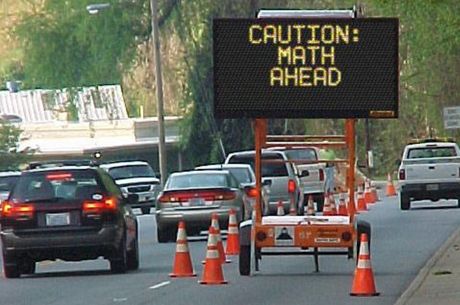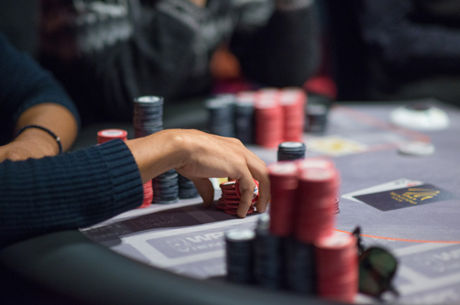How to Take Your Poker Math Beyond Counting Outs, Part 2

This is the second of a two-part article on using a combinations calculator to answer questions about poker probabilities �� questions that go beyond just counting outs.
By the way, a commenter on last week's article pointed out something that I had not known �� you actually don't need either a spreadsheet or to find a combination-calculator website, because Google understands combinatorial commands. In the Google search box, just type in "47 choose 2," and the result is 1,081 �� the number of different ways you can pick 2 cards from a group of 47.
In Part One, I laid out the three basic steps to tackling all problems of this general variety:
- Step 1. Count the total number of possible outcomes.
- Step 2. Count the number of outcomes of the kind we're interested in.
- Step 3. Divide the latter by the former to arrive at a probability.
Let's continue with some harder questions.
Example 3: The prop bet
You've been playing a quiet, sleepy cash game for a few hours. People are bored. To liven things up, one of the players proposes a prop bet: "I'll bet anybody here even money that the next flop will have at least one 5, 6, or 7 in it."
Should you take this bet?
The answer, of course, depends on whether it's better or worse than a 50-50 proposition that a randomly selected flop will have at least one of those cards in it. Let's run the numbers.
Step 1: For one of the examples in Part One of this article, we determined that there are 22,100 possible flops.
Step 2: Next we need to figure out how many flops contain a 5, a 6, or a 7. Based on Example 2 ("Suited flops") in Part One, you might well imagine that it will take some gnarly math to separately calculate how many flops have one, then two, and then three cards of these ranks, in order to get at the total.
Fortunately, we don't have to do that �� we can use a shortcut. We just have to figure out how many flops have none of those three ranks. It follows logically that all other flops must have at least one of them. In this problem, the wording makes it such that we need not differentiate between flops containing one, two, and three of the specified set.
So how many flops have no fives, sixes, or sevens? Imagine a deck with the 12 cards of those ranks removed, leaving 40 cards. We are to pick three cards at random. Returning to our old friend the spreadsheet (or online combinations calculator), we find that COMBIN(40,3) is 9,880.
Step 3: We divide 9,880 by the total number of possible flops �� 22,100. The answer is 0.447, or 44.7% for the probability of a flop with no fives, sixes, or sevens. By simple subtraction, the probability of seeing a flop with at least one card of the three designated ranks must be 100% minus 44.7% = 55.3%.
Conclusion: It's a bad bet to take (as are nearly all prop bets a poker opponent will offer you), because you're wagering 50-50 for a bet that is stacked 55-45 against you. Instead, you should be the one offering this bet to everybody else!
Example 4: The poker room promotion
This is actually the example that prompted me to think about writing this whole article. A friend of mine recently visited a riverboat casino in Shreveport, Louisiana. He told me that the poker room was offering a promotion for their low-stakes, no-limit hold'em games such as he had never seen before.
Anytime the first four board cards contained four to a flush, four to a straight (consecutive, not gutshots), or three of a kind, the house would "splash" the next pot at that table with $300 before the cards were dealt. This naturally raises the question of how often such a qualifying board will occur.
Google won't help you here, because the answer isn't online anywhere.* So let's figure it out for ourselves.
For Step 1, we need to know how many different four-card boards are possible. By now, computing the number of combinations of four cards that can be drawn from a deck of 52 should be child's play for you, using whichever tool is most convenient. The answer is 270,725.
How many of these partial boards will contain three of a kind? This takes some thought. Let's consider aces as an example. We have four different ways of putting together three of the aces from the deck, because COMBIN(4,3) yields 4 �� or you can just realize that you can omit each of the four aces to give four different combinations of the other three.
For each of those four combinations of three aces, there can be any one of the 48 remaining cards other than aces filling the last spot in our four-card board. That means that we could see 4 x 48 = 192 different combinations of three aces plus one non-ace. The set of all four aces would presumably also qualify as "trips" for purposes of this promotion, so we'll bump that number up to 193 different qualifying combinations.
The same reasoning applies to each of the 13 ranks, giving us a total of 193 x 13 = 2,509 different four-card boards that contain three (or, rarely, four) of a kind. Remember, for this calculation we don't care what order they come in; if we did, we would have to use a mathematical tool that calculates permutations, a related but distinct concept.
Now consider the four-to-a-flush criterion. For any given suit of 13 cards, we need to know how many combinations of four could be dealt. You know how to figure that out: COMBIN(13,4) = 715. Any of the four suits will do, and 4 x 715 = 2,860.
How about four to a straight? Consider the lowest, A-2-3-4 (again, the order doesn't matter). Each of those cards might be of any of the four suits, so that's 4 x 4 x 4 x 4 different combinations of four cards that would look like that �� i.e., any of four aces with any of four deuces, any of four treys, and any of four fours. That's a total of 256. However, to avoid duplication with the four-to-a-flush combinations, we need to subtract out the four that are all one suit (i.e., four to a straight flush), leaving us with 252.
There are 11 different groups of four consecutive ranks possible, ranging from A-2-3-4 through J-Q-K-A. That means we have a grand total of 252 x 11 = 2,772 different combinations of four cards that would meet the four-to-a-straight stipulation, without duplicating the sets that we accounted for as four-to-a-flush.
Hang in there �� we're almost done!
Adding up the trips/quads, almost-flushes, and almost-straights, we find 2,509 + 2,860 + 2,772 = 8,141 different four-card boards that will qualify our table for the promotional bonus.
Finally, for Step 3 we divide that 8,141 by the 270,725 from Step 1, for a final answer of 0.030, or almost exactly 3%. Our conclusion, then, is that about 3% of hands that get to fourth street will qualify for the $300 splash-pot on the next deal.
From there, you can make various appropriate assumptions about how much value this promotion adds, on average, to your expected profit per hand or per hour, and decide whether it's worth seeking out.
Just as an aside, were you aware that getting trips, four to a straight, and four to a flush with the first four board cards were all just about equally probable? It was news to me, too. Each of those conditions will be found in roughly 1% of fourth-street boards.
Conclusion
Once you understand how to use a combinations calculator, the number of probability-related poker questions you can answer increases exponentially from what you can do if you are limited to counting single cards (i.e., outs). The limitation is that you'll never be able to do them on the fly while trying to make a tough decision at the table. But later, when you have time, you can explore all sorts of interesting poker math questions that might have stymied you previously.
I'll leave you with three more problems to work out at your leisure, in increasing order of difficulty. Sorry, but unlike your grade-school math textbook, there are no answers to turn to in the back!
Problem #1: What percentage of full, five-card boards will contain a set of quads?
Problem #2: If two players get all their chips in with J?J? versus J?J?, how often will one of them catch at least four more cards of one of his suits to win with a flush?
Problem #3: If you start with AxKx, what is the probability that you will have either aces full of kings or kings full of aces after all five board cards have been dealt?
*After I had written this and sent it to some friends to double-check my math, one of them pointed out to me that while the full calculation for this particular promotion won't be found online, somebody actually has worked out the math on "four-card poker" �� i.e., the number of different ways you can make four-card straights, four-card flushes, and so on. See here.
Robert Woolley lives in Asheville, NC. He spent several years in Las Vegas and chronicled his life in poker on the ��Poker Grump�� blog.
Want to stay atop all the latest in the poker world? If so, make sure to get PokerNews updates on your social media outlets. Follow us on Twitter and find us on both Facebook and Google+!









